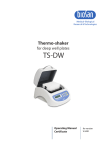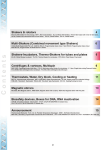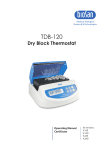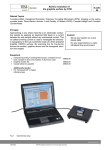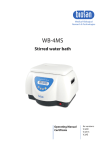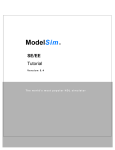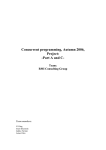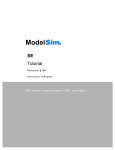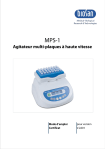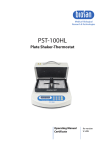Download TS-100C - User manual
Transcript
Medical–Biological Research & Technologies TS-100C Thermo-Shaker with cooling for microtubes and PCR plates Operating Manual Certificate for version V.3EW Contents 1. Safety Precautions 2. General Information 3. Getting Started 4. Operation 5. Calibration 6. Specifications 7. Maintenance 8. Warranty and Claims 9. Declaration of Conformity Page 2 1. Safety precautions The following symbols mean: Caution! Make sure you have fully read and understood the present Manual before using the equipment. Please pay special attention to sections marked by this symbol. Caution! Surfaces can become hot during use! GENERAL SAFETY · Use only as specified in the operating manual provided. · The unit should be used if dropped or damaged. · The unit must be stored and transported in a horizontal position (see package label). · After transportation or storage keep the unit under room temperature for 2-3 hrs before connecting it to the electric circuit. · Use only standard qualitative tubes. · Use only cleaning and decontamination methods recommended by the manufacturer. · Do not make modifications to the design of the unit. ELECTRICAL SAFETY · Connect only to the external power supply unit with voltage corresponding to that on the serial number label. · Use only the external power supply unit provided with this product. · Ensure that the power switch and external power supply are easily accessible during use. · Do not plug the unit into an ungrounded power socket, and do not use an ungrounded extension lead. · Disconnect the unit from electric circuit before moving. · Disconnect the external power supply unit from power socket to turn off the unit. · If liquid penetrates into the unit, disconnect it from the external power supply unit and have it checked by a repair and maintenance technician. · Do not operate the unit in premises where condensation can form. Operating conditions of the unit are defined in the Specifications section. Page 3 DURING OPERATION · Do not leave the operating unit unattended. · Do not impede the platform motion. · Do not operate the unit in environments with aggressive or explosive chemical mixtures. Please contact manufacturer for possible operation of the unit in specific atmospheres. · Do not operate the unit if it is faulty or has been installed incorrectly. · Do not use outside laboratory rooms. · Do not check the temperature by touch. Use a thermometer. BIOLOGICAL SAFETY · It is the user's responsibility to carry out appropriate decontamination if hazardous material is spilt on or penetrates into the equipment. Page 4 2. General Information TS-100С Thermo-shaker provides mixing and temperature control of samples in microtest tubes or PCR plate. This model of thermo-shaker differs from TS-100 with a possibility of cooling samples down to +4°C. Features of TS-100C meet the highest expectations of users according to many parameters: · Fast reaching of specified mixing speed and maintenance of equal amplitude of rotation throughout the Thermo-shaker block; · Stability of maintaining the set temperature in a wide range throughout the Thermo-shaker’s block surface; · With the help of the temperature calibration function the user can calibrate the unit approx. ±6% of the selected temperature to compensate differences in the thermal behaviour of tubes from different manufacturers; · LCD display indicates preset and current values of temperature, speed and time of operation; · Quiet motor operation, compact size, prolonged service life. Functions of heating (up to +100°C), cooling (up to 15°C below room temperature) and mixing can be performed both simultaneously and independently, i.e. the unit implements three devices in one: 1. Shaker; 2. Dry-block thermostat; 3. Thermo-shaker. There are five heating and cooling blocks available, including a block with a plastic lid for PCR-plates. All blocks are mutually interchangeable and can be easily installed on thermo-shaker. The device is applicable in: · genetic analyses — in extraction of DNA, RNA and further sample preparation; · biochemistry for studying of enzymatic reactions and processes; · extraction of metabolites from cellular material. Page 5 3. Getting started 3.1. Unpacking. Remove packing materials carefully and retain them for future shipment or storage of the unit. Examine the unit carefully for any damage incurred during transit. The warranty does not cover in-transit damage. Caution! 3.2. Automatic balancing system in this product produces a light metallike noise when moving the unit which is likely to be heard during unpacking and also during operation (acceleration/deceleration of the platform). It is a normal occurrence and does not indicate a fault or a loose part. Complete set. Package contents: Standard set TS-100C Thermo-shaker .....................................................................1 piece spare rubber belt ................................................................................2 pieces external power supply unit ....................................................................1 piece power cord ............................................................................................1 piece Operating Manual; Certificate ................................................................1 copy Optional accessories SC-18C thermoblock for microtubes u ............................................on request SC-18/02C thermoblock for microtubes v .......................................on request SC-24C thermoblock for microtubes w ............................................on request SC-24NC thermoblock for microtubes x ..........................................on request SC-96AC thermoblock for microplate y and hex-key .......................on request Page 6 3.3. Set up: place the unit upon even horizontal non-flammable surface 30 cm away from any flammable materials; to provide optimum ventilation ensure clearance around the device - 20 cm on rear and side faces; remove protective film from the display; plug the external power supply unit into the socket at the rear side of the unit. 3.4. Thermoblock installation (if thermoblock is not installed) Caution! Thermoblock installation and replacement have to be performed only when the Power switch is turned off and external power supply is disconnect from the device. Choose the thermoblock, connect the plug to the contact terminal according to the scheme on Fig.1/1 on the underside of the thermoblock. Make sure that the connector is mounted tightly. Align the thermoblock so that the warning label is facing the front of the unit. Secure with the four knurled screws (fig.2/1). Note! 3.5. When installing SC-96AC thermoblock, drive one by one 4 screws for several turns and fix them with an hex-key (included in SC96AC thermoblock set). Changing blocks Disconnect the external power supply unit from the device. Remove the four knurled screws (fig.2/1), disconnect the plug (fig.1/1). Select the new thermoblock and install it according to the point 3.4. 1 Fig.1 Thermoblock connection 1 Fig.2 Thermoblock set up Page 7 4. Operation Recommendations during operation Please check the tubes/microwell plates before using, be sure that tubes/ microwell plates are thermoresistant. Don't heat the tubes/microwell plates over the melting point of the material they are made of (use thermoresisting polypropylene tubes). Remember that thin-walled tubes have a higher thermoconducting factor. · Tube caps can open under the action of high temperature (>85°C), thus causing sample volume shrinkage or potential health risk when working with infected material. To prevent such cases it is recommended to use tubes with cap lock of Safe-Lock® type. · It is recommended to fill test tubes up to 75% of the rated volume for efficient mixing. 4.1. Connect external power supply unit to a grounded power socket and set the power switch, located on the rear panel of the unit, to position I (ON). 4.2. The display will turn on with the upper line (Set) showing time, speed and temperature set earlier and the lower line (Actual) showing current readings of the same parameters (thermoblock temperature °C, which automatically starts rising according to the temperature set in the upper line). The time of temperature stabilisation depends on the initial temperature. Setting the parameters Use the readings in the upper line of the display (Set), while setting the required parameters. 4.3. Setting time (TIME). Using the q and p keys (Fig. 3/1) set the required working time interval in hours and minutes (increment - 1 min). Pressing the key for more than 3 s will increase the increment. 4.4. Setting speed (RPM). Using the q and p keys (Fig. 3/2) set the required speed (increment 10 rpm). Pressing the key for more than 3 s will increase the increment. 1 00:00 STOP 1000 000 35.0 35.0 hr : min Thermo-Shaker Fig.3 Control panel Page 8 2 3 4 5 4.5. Setting temperature (T °C). Using the q and p keys (Fig. 3/3) set the necessary temperature (increment 0.1ºC). Pressing the key for more than 3 s will increase the increment. Caution! Thermoblock rotation finishing does not stop the heating/temperature maintenance process. The set parameters can also be changed during operation. Program execution After the thermal stabilisation of the Thermo-Shaker (when the set and current temperature readings become the same): 4.6. Insert tubes into the thermoblock sockets or place the microwell plate on the thermoblock and close the lid. 4.7. Press the RPM-RUN/STOP key (Fig. 3/4). The thermoblock will start rotating and the timer indicator will start counting up the time interval (with 1 min precision). Note! If the rotation speed is set to zero, pressing RPM-RUN/STOP key will start the timer but the thermoblock will not move. 4.8. After finishing the program (after the set time elapses) the thermoblock motion will stop and the timer will show the flashing reading STOP accompanied by the repetitive sound signal until the RPM-RUN/STOP key is pressed. 4.9. If the working time is not set (or is reset) and the timer indicator in the upper line shows 00:00, pressing the RPM-RUN/STOP key will start continuous operation of the device with countdown timer in the lower line (Actual) until the RPM-RUN/STOP key is pressed again. 4.10. If required, there is possibility to restart the timer when it is running. Press the TIME-RUN/STOP key once (Fig. 3/5) to stop the timer. Press the TIMERUN/STOP key again to restart the timer. 4.11. The thermoblock motion can be stopped at any time by pressing the RPMRUN/STOP key. In this case the program realisation and the thermoblock motion will stop and the timer will switch into the STOP mode saving previously set time. Press the RPM-RUN/STOP key to repeat the operation with the same time and speed. Caution! Thermoblock rotation finishing does not stop the heating/temperature maintenance process. 4.12. After finishing the operation set the power switch, located on the rear panel of the unit, in position O (Off) and disconnect the external power supply from electric circuit. Page 9 5. Calibration 5.1. The device is pre-calibrated at the factory (calibrating coefficient is 1.00) for operation with temperatures, measured by a sensor, installed in the heating block. 5.2. To enter the calibration coefficient, hold the TIME-RUN/STOP key (Fig. 3/5) pressed for more than 8 sec to activate calibration mode. The calibration coefficient will be shown on the display (Fig. 5/1). 5.3. Set 1.000 value using the p and q keys (Fig. 3/3) as shown on Fig. 5/1 to restore the factory settings. 5.4. Press the RPM-RUN/STOP key once to exit the calibration mode. Calibration procedure 5.5. Install autonomic sensor (0.5 °C accuracy) into the tubes, placed into the block sockets. 5.6. Set the required temperature in operation mode (e.g. 40 °C). 5.7. After the unit reaches the set temperature (when the set and current temperature readings equal) leave the unit for 30 min for thermal stabilization. 5.8. Let us assume that the readings of independent sensor is 39°C, but the display’s actual temperature is 40 °C (Fig.4). Then it is necessary to add 1°C correction. set temperature Set p. Actual p. 00:00 STOP 1000 0000 hr:min RPM 40.0 40.0 actual temperature T(oC) Fig.4 Control panel in operation mode 5.9. Hold TIME-RUN/STOP key (Fig. 3/5) pressed for more than 8 sec. to activate calibration mode. The following parameters will be shown on the display (Fig. 5): calibration mode sct. 1.000 calibration coefficient temp. with multiplier coeff. temperature from the internal sensor 40.0 40.0 set temp. 40.0 40.0 actual temp. multiplied by last stored actual coefficient Fig.5 Control panel in calibration mode Page 10 5.10. Use the temperature with multiplier coefficient readings to set the new temperature value. Using the Temp. “p ” and “q “ keys (Fig.3/3), change the calibration coefficient (Fig.6A/1) so, that the new temperature value (Fig.6A/2) corresponds to the autonomic sensor temperature. In our example the calibration coefficient will be 0.974 (in range: 0.936 up to 1.063; increment 0.001). Caution! This calibrating coefficient will correct temperature through all the operation range. 5.11. After finishing the calibration press the RPM-RUN/STOP key (Fig.3/4) once to save the changes and exit the calibration mode. 5.12. The display will show calibrated temperature as shown on fig.6B/3 and the unit will continue thermal stabilization according to the previously set temperature. set temperature sct. 0.974 40.0 39.0 calibrating coefficient 40.0 40.0 temp. with multiplier coeff. 00:00 STOP 1000 0000 40.0 39.0 calibrated temperature Fig.6 Control panel in calibration and operation mode Page 11 6. Specifications The unit is designed for operation in cold rooms, incubators and closed laboratory rooms at ambient temperature from +4ºC to +40ºC in a non-condensing atmosphere and maximum relative humidity 80% for temperatures up to 31°C decreasing linearly to 50% relative humidity at 40°C. 6.1. Temperature specifications · Setting range ............................................................................+4 to +100 °C · Control range ............................................................15 below RT to +100 °C · Setting resolution ...................................................................................0.1°C · Stability ................................................................................................± 0.1°C · Accuracy at +37°С...............................................................................± 0.5°C · Uniformity over the thermoblocks at +37°С .........................................± 0.1°C · Average heating speed from +25°C to +100°C...................................5ºC/min · Average cooling speed from 100°C to RT ..............................................................................................5ºC/min from RT to 15°C below RT ..............................................................................1.8ºC/min · Time of thermoblock heating from +25ºC till +37ºC ...............................6 min · Temperature calibration option · Calibration coefficient range..............................from 0.936 to 1.063 (± 0.063) 6.2. General specifications · Speed setting range .................................................................250 -1400 rpm · Speed setting resolution ......................................................................10 rpm · Maximum speed deviation for 250 rpm ................................................................................................................2% for 1400 rpm ..........................................................................................................0.7 % · Digital time setting .....................................................................1 min - 96 hrs · Time setting resolution ...........................................................................1 min · Maximum continuous operation time ................................................96 hours recommended interval between operation sessions not less than 8 hours · Orbit .......................................................................................................2 mm · Display ..................................................................................16x2 signs, LCD · Current/power consumption ................................................12 V, 4.9 A / 60 W · External power supply unit .....input AC 100-240 V 50/60 Hz, output DC 12 V · Dimensions ........................................................................205x230x130 mm · Weight* ..................................................................................................3.7 kg * Page 12 Accurate within ±10%. Optional accessories Description Weight*, kg Catalogue number SC-18C Thermoblock for 20x0.5 ml + 12x1.5ml tubes 0.7 BS-010143-AK SC-18/02C Thermoblock for 20x0.2 ml + 12x1.5ml tubes 0.7 BS-010143-CK SC-24C Thermoblock for 24x2.0 ml microtubes 0.6 BS-010143-EK SC-24NC Thermoblock for 24x1.5 ml microtubes 0.7 BS-010143-GK SC-96AC Thermoblock for 96-well microplate for PCR, w/o skirt, with half skirt, low and high profile 0.7 BS-010143-AK Replacement parts Description Catalogue number Rubber belt 122x6x0.6 BS-000000-S18 * Accurate within ±10%. Note. TS-100 blocks and TS-100C blocks are not interchangeable, i.e.TS-100C blocks cannot be used on TS-100 and vice versa. Biosan is committed to a continuous programme of improvement and reserves the right to alter design and specifications of the equipment without additional notice. Page 13 7. Maintenance 7.1. If the unit requires maintenance, disconnect the unit from the electric circuit and contact Biosan or your local Biosan representative. 7.2. All maintenance and repair operations must be performed only by qualified and specially trained personnel. 7.3. Standard ethanol (75%) or other cleaning agents recommended for cleaning of laboratory equipment can be used for cleaning and decontamination of the unit. 7.4. Rubber belt replacement. For maintenance of reliable operation of the device the producer recommends to replace rubber belts after 1.5 years or 2000 hours of operation time. Disconnect the external power supply unit from the device. Remove 4 fixation screws on the device bottom and remove the bottom plate. Replace the rubber belt (fig.7). Reassemble the device. Fig.7 Rubber belt replacement 8. Warranty and Claims 8.1. The Manufacturer guarantees the compliance of the unit with the requirements of Specifications, provided the Customer follows the operation, storage and transportation instructions. 8.2. The warranted service life of the unit from the date of its delivery to the Customer is 24 months. Contact to your local distributor to check availability of extended warranty. 8.3. If any manufacturing defects are discovered by the Customer, an unsatisfactory equipment claim shall be compiled, certified and sent to the local distributor address. Please visit www.biosan.lv, Technical support section to obtain the claim form. 8.4. The following information will be required in the event that warranty or postwarranty service comes necessary. Complete the table below and retain for your records. Model Serial number Date of sale Page 14 TS-100 Thermo-Shaker for microtubes and PCR plates 9. Declaration of Conformity Version 2.03 - December 2014

















